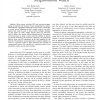Free Online Productivity Tools
i2Speak
i2Symbol
i2OCR
iTex2Img
iWeb2Print
iWeb2Shot
i2Type
iPdf2Split
iPdf2Merge
i2Bopomofo
i2Arabic
i2Style
i2Image
i2PDF
iLatex2Rtf
Sci2ools
ICC
2007
IEEE
2007
IEEE
Secure Aggregation in Sensor Networks Using Neighborhood Watch
Abstract— Many sensor networks (SN) use in-network aggregation to minimize the amount of data transmitted by sensors. Unfortunately, aggregation makes the network more vulnerable: a central server collecting the SN’s results receives less information that could be used to detect and/or mitigate cheating. In this paper we study stealth attacks where an adversary seeks to deceive the system without being detected. We propose several measures to make a sensor network resilient to attack: (a) mutual monitoring and constraint validation, (b) randomized delivery trees, and (c) redundancy in the data supplied by the network. We introduce several protocols to achieve resilience as well as a reputation system to allow detection and exclusion of compromised sensors. We conclude by reporting results of our simulations under several attack models.
| Added | 02 Jun 2010 |
| Updated | 02 Jun 2010 |
| Type | Conference |
| Year | 2007 |
| Where | ICC |
| Authors | Paul Rabinovich, Robert Simon |
Comments (0)

